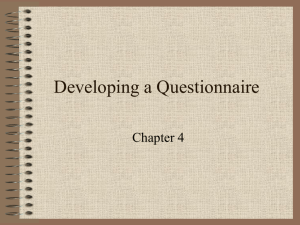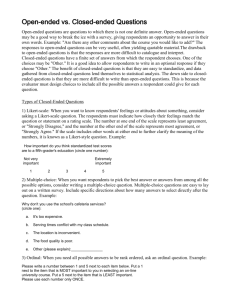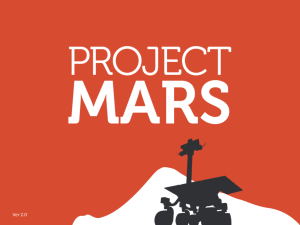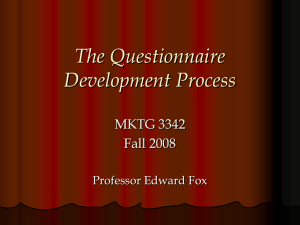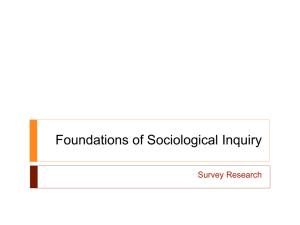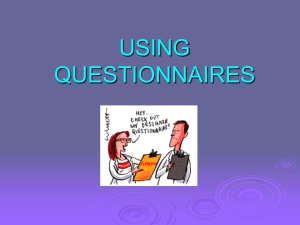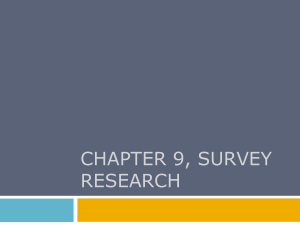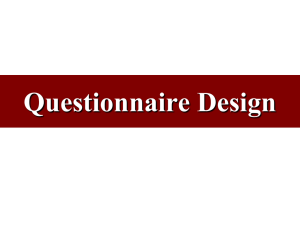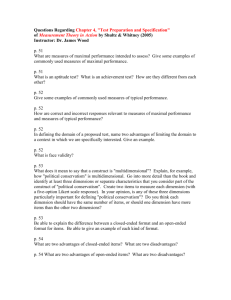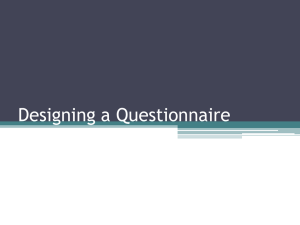Research techniques
advertisement
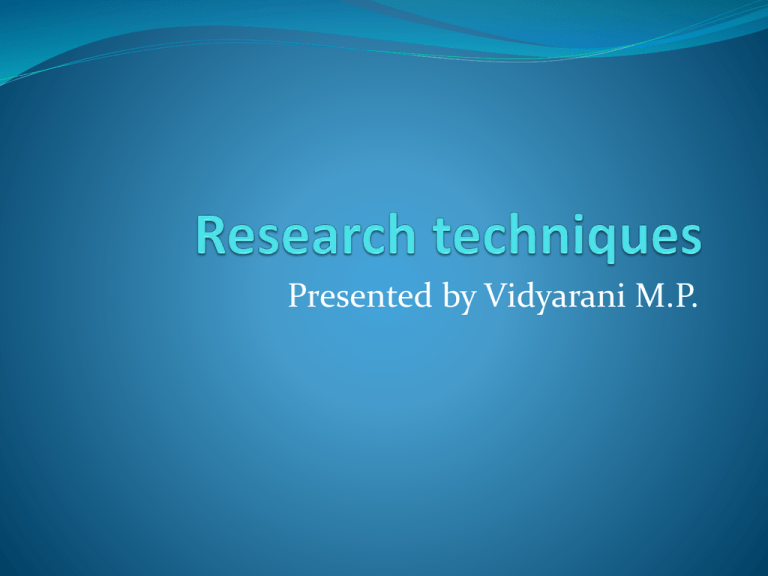
Presented by Vidyarani M.P. Research Research is the systematic investigation into existing or new knowledge. It is used to establish or confirm facts, reaffirm the results of previous work. A research project may also be an expansion on past work in the field. The primary purposes of basic research are documentation, discovery, interpretation, or the research and development of methods and systems for the advancement of human knowledge. Types of Research There are two types of research techniques: scientific and historical. The purpose of both techniques are to use a logical approach to obtain information about a specific subject. Research technique can be applied to a broad range of issues or areas of research. Basic research technique Basic research technique are based on a formal process. The exact order of the steps depend on subject and the reason for the research. The eight steps are the same for both basic and applied research. The first four steps are: formation of a topic, hypothesis, conceptual definition and operational definition. The formation of a topic usually phrased as question. The question is generally with in the researchers field of expertise. The hypothesis is a proposed by the researchers, which is often phrased as a question. The conceptual and operational and definitions provide the scope and focus for the research. The next four steps are: gathering data, analysis, testing and conclusion. The gathering data, analysis and testing steps are the heart of all research. It is very important to use reliable sources, perform experiments, and test the hypothesis thoroughly. If the testing results do not support the hypothesis, the research is not a failure. On the contrary, these results provide an opportunity to revisit the hypothesis and new knowledge is gained. Historical research technique Historical research technique: or methods, are most commonly used to review data from the past and draw conclusion that impact on the present or future. Although commonly used by historians, these techniques are also used by scientific researchers. Using these techniques, they attempt to identify trends, and theorize on the causes of disease outbreaks and epidemic. The next three steps are to analyze the information, validate against other sources and measure the creditability of the information. These steps require the use of multiple sources and a process of questioning all aspects of the information. This includes using generally accepted knowledge about the time period in question, historical facts and physical evidence The process of historical research requires a significant amount of reading, translating, researching and discussion. The volume of information required to support a historical theory is quite substantial. This method is often used by professionals with an extensive background in a specific subject. questionnaire A questionnaire is a research instrument consisting of a series of questions and other prompts for the purpose of gathering information from respondents. Although they are often designed for statistical analysis of the responses, this is not always the case. The questionnaire was invented by Sir Francis Galton Types of question Usually, a questionnaire consists of a number of questions that the respondent has to answer in a set format. A distinction is made between open-ended and closed-ended questions. An open-ended question asks the respondent to formulate his own answer, whereas a closed-ended question has the respondent pick an answer from a given number of options. The response options for a closedended question should be exhaustive and mutually exclusive. Four types of response scales for closed-ended questions are distinguished: Open-Ended Questions “An open question is likely to receive a long answer”. Although any question can receive a long answer, open questions deliberately seek longer answers, and are the opposite of closed questions. The ability to ask open-ended questions is very important in many vocations, including education, counseling, mediation, sales, investigative work and journalism. An open-ended question is designed to encourage a full, meaningful answer using the subject's own knowledge and/or feelings. It is the opposite of a closed-ended question, which encourages a short or single-word answer. Open-ended questions also tend to be more objective and less leading than closed-ended questions Open-ended questions typically begin with words such as "Why" and "How", or phrases such as "Tell me about...". Often they are not technically a question, but a statement which implicitly asks for a response. Closed-ended question A closed-ended question is a question format that provide respondents with a list of answer choices from which they must choice to answer the question. Commonly these type of questions are in the from of multiple choices, either with one answer or with check-all-that-apply, but also can be in scale format, where respondent should decide to rate the situation in along the scale continuum, like Liker questions There are two definitions that are used to describe closed questions. A common definition is: “A closed question can be answered with either a single word or a short phrase.” Thus 'How old are you?' and 'Where do you live?' are closed questions. A more limiting definition is: “A closed question can be answered with either 'yes' or 'no‘. Thus 'Are you happy?' and 'Is that a knife I see before me?' are closed questions, whilst 'How are you?' and even 'How old are you?' are not, by this definition, closed. This limited definition is also sometimes called a 'yes or no' question, for obvious reasons Purpose This type of question should be used when surveyors want respondents to provide an answer from a group of selected choices. This type of questions can use ordinal or nominal scales. This make easy the job of processing information. Open-ended questions are conversely, much more timeconsuming at the time of processing. characteristics Open questions have the following characteristics They ask the respondent to think and reflect. They will give you opinions and feelings. They hand control of the conversation to the respondent. Basic rules for construction of questionnaire Use statements which are interpreted in the same way by members of different subpopulations of the population of interest. Use statements where persons that have different opinions or traits will give different answers. Think of having an "open" answer category after a list of possible answers. Use only one aspect of the construct you are interested in per item. Use positive statements and avoid negatives or double negatives. Do not make assumptions about the respondent. Use clear and comprehensible wording, easily understandable for all educational levels Use correct spelling, grammar and punctuation. Avoid items that contain more than one question per item (e.g. Do you like strawberries and potatoes?). The standard questionnaire design is a set of questions with fixed alternatives. These alternatives could be dichotomous (having only two options e.g. yes/no), multiple options or rank scaling, etc. All the readers need to do is tick the most appropriate answer according to them. Any questionnaire, be it a health questionnaire or a product questionnaire, must have a specific objective. Generally questionnaires have subjective/objective and qualitative/quantitative options depending on their type. A customer satisfaction questionnaire may have more qualitative/subjective parameters for gauging. Questions should be framed in a simple language and care should be taken to avoid grammatical and spelling mistakes. For instance, if an employee questionnaire has such errors it can reflect poorly on the company. Questions should have clarity and must convey the same meaning to all kinds of readers, so it is best to use direct questions rather than ambiguous ones. The ability to ask open-ended questions is very important in many vocations, including education, counseling, mediation, sales, investigative work and journalism. Thank you
